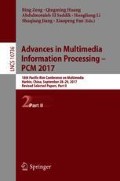Abstract
This paper presents a simple approach for detecting salient regions in stereo images. The approach computes saliency by considering three factors: disparity influence, central bias and spatial dissimilarity. Firstly, an image is split into equal-sized patches to be down-sampled. Next, disparity influence is estimated based on the disparity map. Besides, central bias value is assigned to every patch and spatial dissimilarity is measured between patches in reduced dimensional space. Thereafter, the product of all factors extracted from the image is computed. Finally, through a process of normalization, the saliency map is obtained. In the experiments four state-of-the-art methods are used for comparison with PSU stereo saliency benchmark dataset (SSB). The experimental results show that our method has better performance than the others for stereo salient region detection.
Access this chapter
Tax calculation will be finalised at checkout
Purchases are for personal use only
References
Achanta, R., Hemami, S.S., Estrada, F.V., Susstrunk, S.: Frequency-tuned salient region detection, pp. 1597–1604 (2009)
Achanta, R., Susstrunk, S.: Saliency detection for content-aware image resizing, pp. 1005–1008 (2009)
Bruce, N.D.B., Tsotsos, J.K.: Saliency based on information maximization, pp. 155–162 (2005)
Cheng, M., Mitra, N.J., Huang, X., Torr, P.H.S., Hu, S.: Global contrast based salient region detection. IEEE Trans. Pattern Anal. Mach. Intell. 37(3), 569–582 (2015)
Koch, C.: Biophysics of Computation: Information Processing in Single Neurons. Oxford University Press, New York (1999)
Desingh, K., Madhava Krishna, K., Rajan, D., Jawahar, C.V.: Depth really matters: improving visual salient region detection with depth (2013)
Duan, L., Wu, C., Miao, J., Qing, L., Fu, Y.: Visual saliency detection by spatially weighted dissimilarity, pp. 473–480 (2011)
Gao, D., Mahadevan, V., Vasconcelos, N.: The discriminant center-surround hypothesis for bottom-up saliency, pp. 497–504 (2007)
Goferman, S., Zelnikmanor, L., Tal, A.: Context-aware saliency detection, pp. 2376–2383 (2010)
Gopalakrishnan, V., Hu, Y., Rajan, D.: Salient region detection by modeling distributions of color and orientation. IEEE Trans. Multimed. 11(5), 892–905 (2009)
Guo, W., Xu, C., Ma, S., Xu, M.: Visual attention based motion object detection and trajectory tracking. In: Qiu, G., Lam, K.M., Kiya, H., Xue, X.-Y., Kuo, C.-C.J., Lew, M.S. (eds.) PCM 2010. LNCS, vol. 6298, pp. 462–470. Springer, Heidelberg (2010). https://doi.org/10.1007/978-3-642-15696-0_43
Harel, J., Koch, C., Perona, P.: Graph-based visual saliency, pp. 545–552 (2006)
Hou, X., Zhang, L.: Saliency detection: a spectral residual approach, pp. 1–8 (2007)
Huang, T., Tian, Y., Li, J., Yu, H.: Salient region detection and segmentation for general object recognition and image understanding. Sci. China Ser. F Inf. Sci. 54(12), 2461–2470 (2011)
Huang, Z., He, F., Cai, X., Zou, Z., Liu, J., Liang, M., Chen, X.: Efficient random saliency map detection. Sci. China Ser. F Inf. Sci. 54(6), 1207–1217 (2011)
Itti, L., Koch, C., Niebur, E.: A model of saliency-based visual attention for rapid scene analysis. IEEE Trans. Pattern Anal. Mach. Intell. 20(11), 1254–1259 (1998)
Judd, T., Ehinger, K.A., Durand, F., Torralba, A.: Learning to predict where humans look, pp. 2106–2113 (2009)
Kanatani, K.: Geometric information criterion for model selection. Int. J. Comput. Vis. 26(3), 171–189 (1998)
Lang, C., Nguyen, T.V., Katti, H., Yadati, K., Kankanhalli, M., Yan, S.: Depth matters: influence of depth cues on visual saliency. In: Fitzgibbon, A., Lazebnik, S., Perona, P., Sato, Y., Schmid, C. (eds.) ECCV 2012. LNCS, pp. 101–115. Springer, Heidelberg (2012). https://doi.org/10.1007/978-3-642-33709-3_8
Li, J., Tian, Y., Huang, T., Gao, W.: Cost-sensitive rank learning from positive and unlabeled data for visual saliency estimation. IEEE Signal Process. Lett. 17(6), 591–594 (2010)
Li, J., Tian, Y., Huang, T., Gao, W.: Probabilistic multi-task learning for visual saliency estimation in video. Int. J. Comput. Vis. 90(2), 150–165 (2010)
Li, Z.: A saliency map in primary visual cortex. Trends Cognit. Sci. 6(1), 9–16 (2002)
Li, Z., Fang, T., Huo, H.: A saliency model based on wavelet transform and visual attention. Sci. China Ser. F Inf. Sci. 53(4), 738–751 (2010)
Liu, C., Yuen, J., Torralba, A.: Sift flow: dense correspondence across scenes and its applications. IEEE Trans. Pattern Anal. Mach. Intell. 33(5), 978–994 (2011)
Margolin, R., Zelnikmanor, L., Tal, A.: Saliency for image manipulation. Vis. Comput. 29(5), 381–392 (2013)
Niu, Y., Geng, Y., Li, X., Liu, F.: Leveraging stereopsis for saliency analysis, pp. 454–461 (2012)
Rahtu, E., Kannala, J., Salo, M., Heikkilä, J.: Segmenting salient objects from images and videos. In: Daniilidis, K., Maragos, P., Paragios, N. (eds.) ECCV 2010. LNCS, vol. 6315, pp. 366–379. Springer, Heidelberg (2010). https://doi.org/10.1007/978-3-642-15555-0_27
Seo, H.J., Milanfar, P.: Static and space-time visual saliency detection by self-resemblance. J. Vis. 9(12), 15 (2009)
Tatler, B.W.: The central fixation bias in scene viewing: selecting an optimal viewing position independently of motor biases and image feature distributions. J. Vis. 7(14), 4 (2007)
Tatler, B.W., Baddeley, R., Gilchrist, I.D.: Visual correlates of fixation selection: effects of scale and time. Vis. Res. 45(5), 643–659 (2005)
Treisman, A., Gelade, G.A.: A feature-integration theory of attention. Cognit. Psychol. 12(1), 97–136 (1980)
Acknowledgments
This research is partially sponsored by National Natural Science Foundation of China [61370113, 61672070, 91546111, 61572004]; and Beijing Municipal Natural Science Foundation [4152005, 4152006, 4162058]; the Science and Technology Program of Tianjin [15YFXQGX0050]; the Science and technology planning project of Qinghai Province [2016-ZJ-Y04]; the Beijing Municipal Education Commission Science and Technology Program [KZ201610005009, KM201610005022, KM201510005015].
Author information
Authors and Affiliations
Corresponding author
Editor information
Editors and Affiliations
Rights and permissions
Copyright information
© 2018 Springer International Publishing AG, part of Springer Nature
About this paper
Cite this paper
Duan, L., Liang, F., Ma, W., Qiu, S. (2018). Stereo Saliency Analysis Based on Disparity Influence and Spatial Dissimilarity. In: Zeng, B., Huang, Q., El Saddik, A., Li, H., Jiang, S., Fan, X. (eds) Advances in Multimedia Information Processing – PCM 2017. PCM 2017. Lecture Notes in Computer Science(), vol 10736. Springer, Cham. https://doi.org/10.1007/978-3-319-77383-4_25
Download citation
DOI: https://doi.org/10.1007/978-3-319-77383-4_25
Published:
Publisher Name: Springer, Cham
Print ISBN: 978-3-319-77382-7
Online ISBN: 978-3-319-77383-4
eBook Packages: Computer ScienceComputer Science (R0)

